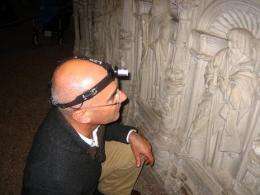The truth behind Tudor tombs is out there

(PhysOrg.com) -- An Oxford historian is working with space scientists and art historians to analyse Renaissance Tomb-Monuments in Suffolk, which the team hope will unlock secrets of the Tudor Reformation.
Dr Steven Gunn of the Faculty of History and academics from the University of Leicester will analyse the great Renaissance monuments of Thomas Howard, third Duke of Norfolk (d. 1554) and Henry Fitzroy, Duke of Richmond (d.1536), who was Henry VIII’s illegitimate son.
The interdisciplinary research programme, which also involves Yale and English Heritage, is funded by a grant for £497,000 and three PhD studentships from the Science and Heritage Programme of the Arts and Humanities Research Council and the Engineering and Physical Sciences Research Council.
The monuments were moved from Thetford Priory in Norfolk to Framlingham Parish Church in Suffolk in the mid-16th century, and researchers believe they were dramatically altered by the relocation. Scientists will apply techniques from space science to the monuments to work out how the statues would originally have looked, without needing to physically touch the monuments.
Dr Gunn, who will provide historical context for the scientists’ findings, said: ‘The Howards are central to our understanding of the artistic development of 16th-century England. They were also right at the heart of religious and political change, the third duke resisting Protestantism, his son the earl of Surrey translating the psalms into English and his grandson the fourth duke executed for trying to marry Mary, Queen of Scots.’
Dr Gunn is supervising a doctoral study funded by the project on tombs and noble identity in England, 1485-1572. The doctoral student, Kirsten Claiden-Yardley, is investigating how noble families used tombs, portraits, family histories and other commissions to project their power. The aim is to put the Howard tombs in context and understand the impression they would have made on contemporaries.
Dr Philip Lindley, an art historian at Leicester who is the project’s principal investigator, said: ‘Key to this programme is the innovative employment of techniques borrowed from space science, principally three-dimensional scanning and non-destructive materials analysis, to solve a complex set of historical, archaeological and art-historical problems.
‘Both monuments seem to have been dramatically altered when they were moved in the middle of the sixteenth century from their original locations in Thetford Priory to Framlingham Parish Church, where they now stand. Puzzlingly, pieces excavated at Thetford in the 1930s seem to have originally belonged to these monuments and this suggests that they used to look very different from what we now see.
‘We shall virtually disassemble the monuments and reconstruct their original forms for the first time in half a millennium, trying to integrate the excavated fragments in our virtual reconstructions. It is as if we have two (or more) three-dimensional jigsaws: we need first to sort the pieces out and then put them back together.’
The project will function as a case study, adapting techniques for analysis, interpretation and display, to make them widely transferable for future research.
Provided by Oxford University

















